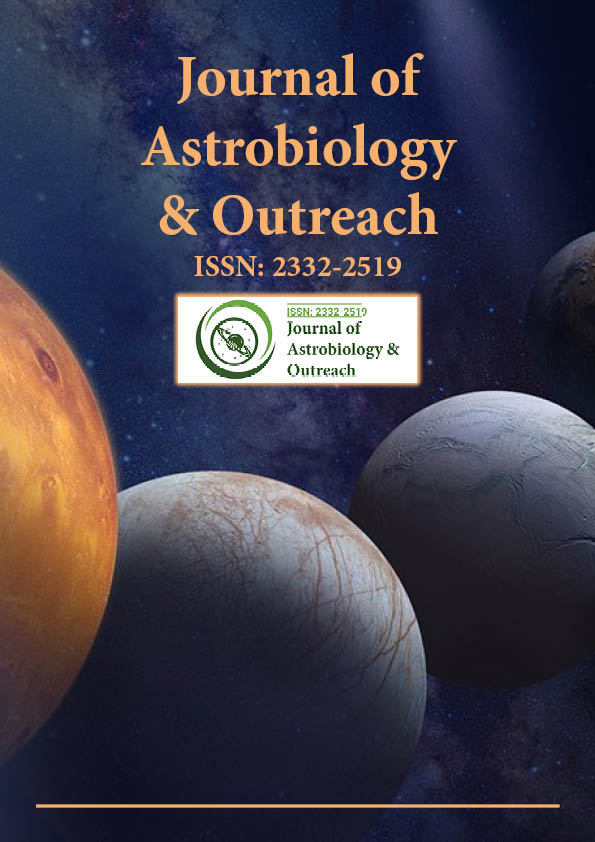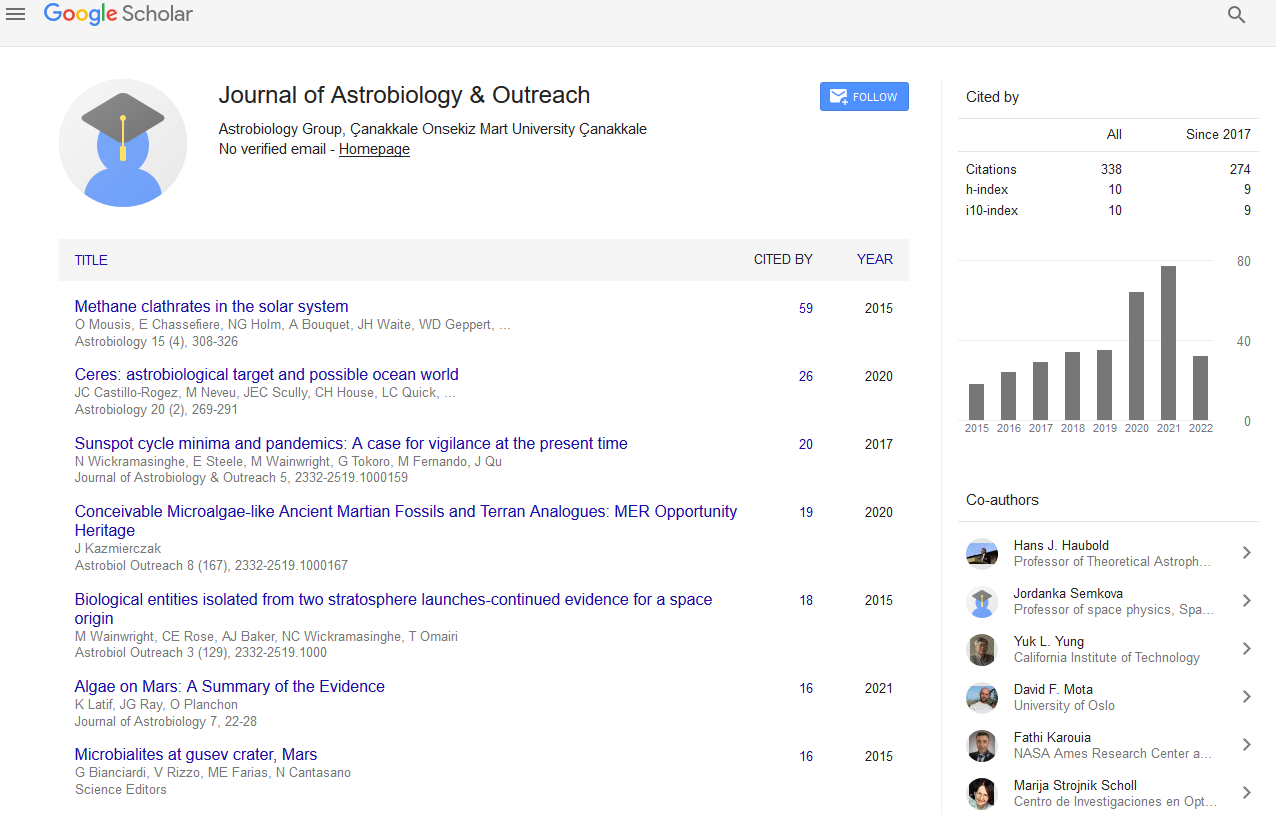Indexed In
- Open J Gate
- Academic Keys
- JournalTOCs
- RefSeek
- Hamdard University
- EBSCO A-Z
- OCLC- WorldCat
- Google Scholar
Useful Links
Share This Page
Journal Flyer

Open Access Journals
- Agri and Aquaculture
- Biochemistry
- Bioinformatics & Systems Biology
- Business & Management
- Chemistry
- Clinical Sciences
- Engineering
- Food & Nutrition
- General Science
- Genetics & Molecular Biology
- Immunology & Microbiology
- Medical Sciences
- Neuroscience & Psychology
- Nursing & Health Care
- Pharmaceutical Sciences
Commentary - (2024) Volume 12, Issue 4
Debris Movement Mechanisms and Spacecraft Survivability in Venusian Orbits
Javier Rodriguez*Received: 29-Nov-2024, Manuscript No. JAO-24-28010; Editor assigned: 02-Dec-2024, Pre QC No. JAO-24-28010 (PQ); Reviewed: 16-Dec-2024, QC No. JAO-24-28010; Revised: 23-Dec-2024, Manuscript No. JAO-24-28010 (R); Published: 30-Dec-2024, DOI: 10.35248/2332-2519.24.12.363
Description
The exploration of Venus and the surrounding space environments has long engaged the scientific community, but recent advancements in space missions have highlighted new challenges regarding the risk to spacecraft in Venusian orbits. The investigation of debris propagation mechanisms and spacecraft survivability in Venus synchronous and high-altitude mission orbits is an essential area of study, as it helps to identify and minimize the dangers presented by space debris in these critical mission areas. As the space industry accelerates its ambitions, particularly for planetary exploration and scientific missions to Venus, understanding these risks is essential for the success and sustainability of future missions.
Space debris, which includes inactive satellites, rocket stages and smaller pieces resulting from collisions or dismantling of objects, implements a significant risk to operational spacecraft. In the context of Venus missions, which often require orbital positions in synchronous orbits and high-altitude ranges, the issue becomes even more critical. These orbits, while optimal for scientific research and communications, are subject to complex debris dynamics due to the gravitational and atmospheric influences of both Venus and its neighboring regions in the solar system. Understanding how debris propagates and the associated risks to spacecraft in these orbits is fundamental to ensuring the safety and effectiveness of these missions.
One of the fundamental aspects of this investigation involves analyzing the movement and distribution of debris in these specific orbital regions. In the case of Venus synchronous orbits, which are approximately 18,000 to 20,000 km above the surface, debris accumulation tends to be influenced by both Venus’s strong gravity and solar radiation pressure. The exchange between these forces can cause debris to drift, leading to a potential collision hazard for operational spacecraft. Furthermore, debris in high-altitude orbits around Venus is more likely to remain in orbit for extended periods due to the lack of substantial atmospheric drag, unlike Low Earth Orbit (LEO), where objects are typically deorbited within a few years.
Models of debris propagation mechanisms are essential for simulating how space debris behaves under different conditions, including gravitational perturbations, solar winds and the Venusian ionosphere. These models help in predicting debris movement, understanding the likelihood of collision risks and determining safe trajectories for spacecraft operating in Venus synchronous or high-altitude orbits. By tracking the behavior of debris, scientists can better understand how to minimize the risk to spacecraft, potentially through collision avoidance maneuvers or by adjusting orbital designs to avoid regions with higher debris densities.
Another critical area of study in debris propagation dynamics is the long-term evolution of debris clouds. In Venusian orbits, the debris may remain in orbit for decades, gradually spreading over time due to gravitational interactions and solar radiation. As debris from older spacecraft or pieces from previous collisions accumulate, the risk of secondary impacts increases, creating a feedback loop that exacerbates the debris problem. This cycle of debris accumulation and propagation is a significant concern for future missions, especially in the context of long-duration missions that require stable orbits to facilitate scientific observations and data transmission.
The importance of assessing debris mechanisms and spacecraft survivability is further highlighted by the growing interest in Venus exploration. NASA's VERITAS and ESA's EnVision missions, which aim to investigate Venus' geophysical and atmospheric properties, will likely need to operate in these critical orbits. Understanding the debris environment in Venusian space is paramount for these missions to avoid potential damage that could compromise their scientific objectives. Additionally, other missions targeting the exploration of Venus' moons or interplanetary scientific observations will require accurate models and risk assessments to ensure their success.
In conclusion, the investigation of debris propagation mechanisms and spacecraft survivability risks in Venus synchronous and high-altitude mission orbits is critical for the success of Venus exploration missions. By understanding the complex behavior of space debris in these orbits and designing spacecraft that can withstand potential impacts, future missions will be better equipped to overcome the challenges created by these extreme environments. As the exploration of Venus continues to advance, ensuring that spacecraft can survive in these critical orbits will be an important factor in revealing the scientific mysteries of our neighboring planet. The research and technological advancements made in this area will not only improve our understanding of Venus but also contribute to the overall safety and sustainability of space exploration in the broader solar system.
Citation: Rodriguez J (2024). Debris Movement Mechanisms and Spacecraft Survivability in Venusian Orbits. J Astrobiol Outreach. 12:363.
Copyright: © 2024 Rodriguez J. This is an open-access article distributed under the terms of the Creative Commons Attribution License, which permits unrestricted use, distribution, and reproduction in any medium, provided the original author and source are credited.

